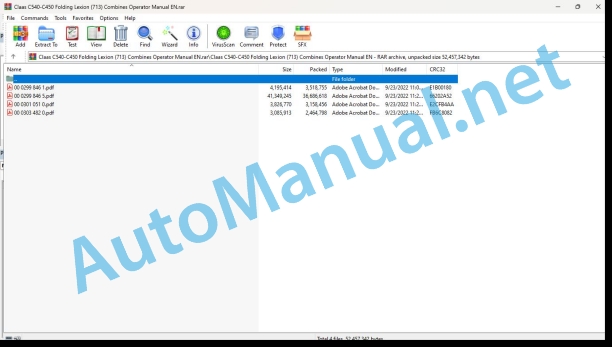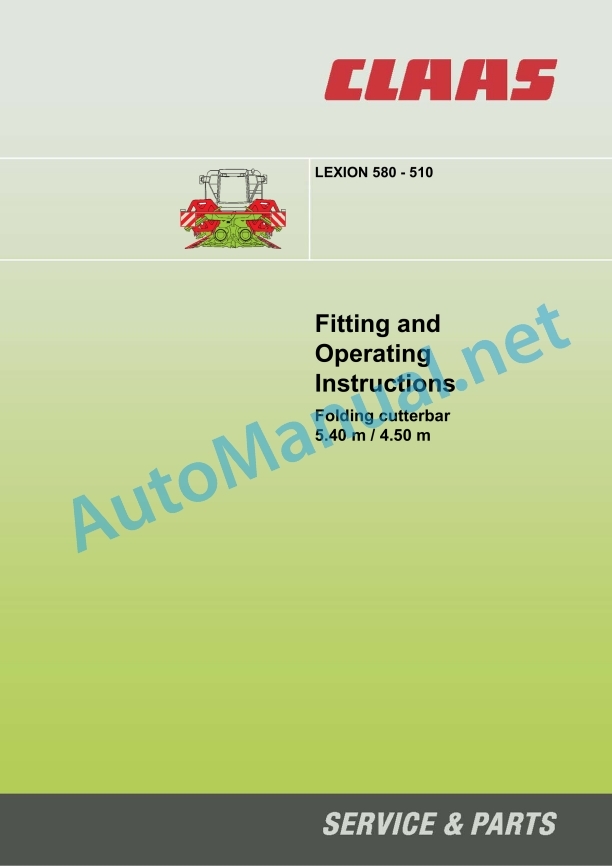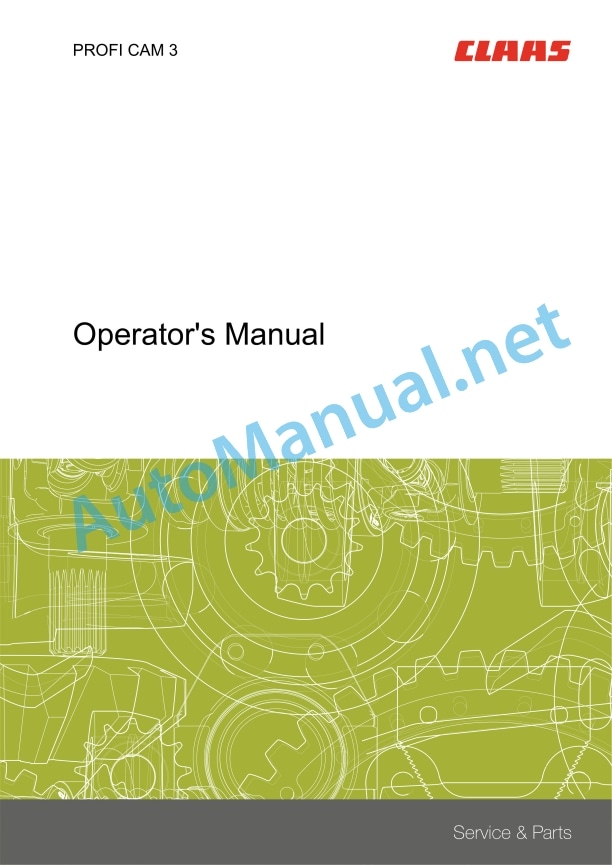Claas C540-C450 Folding Lexion (713) Combines Operator Manual EN
$50.00
- Model: C540-C450 Folding Lexion (713) Combines
- Type Of Manual: Operator Manual
- Language: EN
- Format: PDF(s)
- Size: 43.7 MB
File List:
00 0299 846 1.pdf
00 0299 846 5.pdf
00 0301 051 0.pdf
00 0303 482 0.pdf
00 0299 846 1.pdf:
Introduction
Introduction
Table of contents
Table of contents
General Information
Vehicle type approval
Important information
Identification plate / Serial number
Safety rules
Safety rules
Safety locks
Feed rake safety locks
Reel safety lock
Safety decals with pictorials
Specifications
Weights / Dimensions / Safety devices
Additional weights
Prior to operation
Carry out prior to initial operation
Driving lights / Cutterbar cylinder
Driving lights for road use
Changing the driving lights (up to serial no. …)
Changing the driving lights (from serial no. …)
Safety lighting rail on the cutterbar
Removing the transport fixtures
Third cutterbar cylinder
Adjusting the cutterbar floatation springs
Accessory equipment
Additional headlights
Fitting the switches and the additional headlights
Installing the push buttons for switching
Mounting the additional headlights on both sides
Adjusting the additional headlights
Operation
Cutterbar skids
Adjusting the cutterbar skids
Cutting angle adjustment
Adjusting the cutting angle
Mounting the spacer bar
Mounting the coupling brackets
Locking the coupling lug after fitting the cutterbar
Unlocking the coupling lug before removing the cutterbar
Mounting the shaft extension
Mounting the extension to the intermediate drive shaft (LEXION 530 – 510)
Fitting the cutterbar
Tilting the cutterbar from the transport position
Installing and removing the cutterbar
Installing the cutterbar when folded in (cutterbar in the transport position)
Locking the cutterbar at top and bottom on both sides
Connecting the universal coupling
Changing the cutterbar from transport position to working position
Fitting the universal drive shafts LEXION MONTANA (from serial no. 71300231)
Removing standard universal drive shafts
Installing the universal drive shaft for LEXION MONTANA
Changing the cutterbar from working position to transport position
Aligning the cutterbar / removing the cutterbar
Aligning the cutterbar (machines without Auto-Contour)
Removing the cutterbar
Adjustments on the cutterbar
Crop dividers
Outer deflector
Adjusting the dividers
Crop lifters
Removing the knife
Installing the knife
Adjusting the knife height
Aligning the knife clips
Spare knife
Adjusting the reel height
Fine height adjustment of the reel
Reel drive
Reel fore and aft adjustment
Feed auger
Adjusting the clearance to the cutterbar bottom plate
Height adjustment of the feed auger
Adjusting the intake finger position
Safety feature
Cutterbar skids
Malfunction, possible cause and/or remedy
Maintenance
Maintenance schedules and lubricants charts
Maintenance schedule
Lubricants chart
Transmissions
Knife drive transmission
Spring-loaded cylinders / Drive chains / Inductive sensors
Adjusting the spring-loaded cylinders for knife drives
Tensioning the drive chains
Tensioning the reel drive chain
Cleaning the guide rails of the locking cylinder
Aligning the double fingers
Adjusting the reel limit switch
Adjusting the locking pawl at the centre reel guide
Cleaning the spaces of the supporting arm bearings
Cleaning the coupling lug areas
Suggestions for winter storage
Lubrication chart
Lubricants and notes
00 0299 846 5.pdf:
C 540C 450
Table of contents
1 Introduction
1.1 General information
1.1.1 Validity of manual
1.1.2 Information about this Operator’s Manual
1.1.3 Symbols and notes
1.1.4 Optional equipment
1.1.5 Qualified specialist workshop
1.1.6 Maintenance notes
1.1.7 Warranty notes
1.1.8 Spare parts and technical questions
1.2 Intended use
1.2.1 Intended use
1.2.2 Reasonably foreseeable misuse
2 Safety
2.1 Identifying warnings
2.1.1 Hazard signs
2.1.2 Signal word
2.2 Safety rules
2.2.1 Importance of Operator’s Manual
2.2.2 Observing safety decals and warnings
2.2.3 Requirements for all persons working with the machine
2.2.4 Hazard areas
2.2.5 Standing between machine and front attachment
2.2.6 Coupling the machine to the front attachment
2.2.7 Danger of injury from rotating shafts
2.2.8 Structural changes
2.2.9 Optional equipment and spare parts
2.2.10 Operation only following proper putting into operation
2.2.11 Technical condition
2.2.12 Danger from damage to the machine
2.2.13 Keeping the safety devices functional
2.2.14 Personal protective equipment
2.2.15 Wearing suitable clothing
2.2.16 Removing dirt and loose objects
2.2.17 Preparing the machine for road travel
2.2.18 Unsuitable operating utilities
2.2.19 Safe handling of operating materials and auxiliary materials
2.2.20 Environmental protection and disposal
2.2.21 Electrocution by electrical system
2.2.22 Pressurised fluids
2.2.23 Only carry out work on the machine when it is stopped
2.2.24 Maintenance operations and repair work
2.2.25 Raised machine parts and loads
2.2.26 Hazard from welding work
2.3 Safety marking
2.3.1 Layout of safety decals
2.3.2 Safety decals on the front attachment
2.4 Safety devices
2.4.1 Fitting the reel safety lock
2.4.2 Moving out the reel safety lock
2.4.3 Fitting the finger bar safety device
3 Machine description
3.1 Overview and method of operation
3.1.1 Overview
3.1.2 Function of folding cutterbar
3.2 Identification plates and identification numbers
3.2.1 Identification plate of front attachment
4 Operating and display elements
4.1 Cab and operator’s platform
4.1.1 External control panel
4.1.2 Control terminal
5 Technical specifications
5.1 Folding cutterbar
5.1.1 Compatible machines
5.1.2 Dimensions
5.1.3 Weights
5.1.4 Speeds
5.1.5 Intake auger
5.2 Operating utilities
5.2.1 Lubricants
6 Machine preparation
6.1 Switching off and securing the machine
6.1.1 Switching off and securing the machine
6.2 Prior to putting into operation
6.2.1 Prior to initial operation
6.2.2 Installing the shaft extension
Left side of feeder housing
Right side of feeder housing
6.2.3 Setting the skids to working position
6.2.4 Removing the transport safety equipment
Removing the transport pallet*
Removing the reel transport safety equipment
6.2.5 Installing the spacer frame
6.2.6 Installing the retainers
Standard feeder housing / V-type feeder housing
MONTANA feeder housing
HP feeder housing
6.3 Loading the front attachment
6.3.1 Loading and lashing down the front attachment
6.4 Mounting the front attachment
6.4.1 Installing the front attachment
6.4.2 Adapting the scraper profiles to the feeder housing
6.4.3 Preparing the locking
Machine with hydraulic cylinder (1) (AUTO CONTOUR)
Machine without hydraulic cylinder (1) (CONTOUR)
6.4.4 Suspending the front attachment
6.4.5 Locking the front attachment
Lower locking mechanisms
Upper locking mechanisms
6.4.6 Installing the inner universal drive shaft half for MONTANA
6.4.7 Installing the universal drive shaft
6.4.8 Fitting the universal drive shaft guard chain
Standard universal drive shaft on left side of front attachment
Standard universal drive shaft on right side of front attachment
MONTANA universal drive shaft
6.4.9 Mounting the multi-coupler
6.4.10 Aligning the front attachment to a horizontal position
6.5 Removing the front attachment
6.5.1 Removing the front attachment
6.5.2 Removing the multi-coupler
6.5.3 Removing the universal drive shaft
6.5.4 Removing the universal drive shaft for MONTANA
6.5.5 Unlocking the front attachment
Upper locking mechanisms
Lower locking mechanisms
6.5.6 Unhinging the front attachment
7 Operation
7.1 Driving the machine
7.1.1 Preparing road travel
7.1.2 Adjust the front attachment to the transport position
Folding the front attachment
7.1.3 Fitting the safety bar
7.1.4 Adjusting the upper drive lights for folding front attachments
7.1.5 Preparing fieldwork
7.1.6 Adjusting the front attachment to the working position
Aligning the front attachment
Folding out the front attachment
7.1.7 Prior to fieldwork
7.1.8 Checking the crop pick-up
7.2 Crop feeding
7.2.1 Installing the long crop dividers
7.2.2 Folding out the long crop dividers
7.2.3 Folding in the long crop dividers
7.2.4 Adjusting the long crop dividers
Adjusting the height of crop dividers
Adjusting the divider centre plate
Adjusting the inner deflectors
Adjusting the outer deflectors
7.2.5 Installing the outer deflector
7.2.6 Removing the outer deflector
7.2.7 Installing the
7.2.8 Folding out the
7.2.9 Folding in the
7.2.10 Adjusting the reel tines
7.3 Feeder unit
7.3.1 Adjusting the scraper profile
7.3.2 Adjusting the intake auger position
7.3.3 Adjusting the intake auger fingers
7.3.4 Removing the auger plate extensions
7.3.5 Change the speed of the intake auger
7.4 Mower unit
7.4.1 Installing crop lifters
7.5 Ground guidance
7.5.1 Adjusting the skids
8 Faults and remedies
8.1 Causes and remedies
8.1.1 Improving crop flow
8.1.2 Folding mechanism
8.2 Crop feeding
8.2.1 Checking the reel height basic setting
8.2.2 Replacing the reel tines
8.2.3 Adjusting the reel speed sensor
8.2.4 Checking the reel limit switch
8.3 Feeder unit
8.3.1 Changing the intake auger fingers
8.4 Mower unit
8.4.1 Changing the knives
Removing the knife
Installing the knife
8.4.2 Replacing the riveted knife section
8.4.3 Replacing the knife section
8.4.4 Replacing the double fingers
8.4.5 Aligning the double fingers
9 Maintenance
9.1 Maintenance intervals
9.1.1 Every 10 operating hours or daily
9.1.2 After the first 100 operating hours
9.1.3 Every 100 operating hours
9.1.4 Every 250 operating hours
9.1.5 Every 500 operating hours or annually
9.1.6 Preserving the front attachment
9.2 Lubrication plan
9.2.1 Grease the grease points every 10 operating hours
Applies to: MONTANA
9.2.2 Grease the grease points every 100 operating hours
9.2.3 Grease the grease points every 250 operating hours
9.2.4 Grease the grease points every 500 operating hours
9.3 Transmission, clutch and driveshaft
9.3.1 Checking the oil level of the knife drive gearboxes
9.3.2 Changing the knife drive gearboxes’ oil
Draining the oil
Topping up oil
9.4 Drives
9.4.1 Adjusting the drives
9.4.2 Check the tension spring cylinder with a gauge rod.
9.4.3 Adjusting the intake auger drive chain (K01/K03)
9.4.4 Adjusting the reel drive chain (K02)
9.5 Hydraulic system
9.5.1 Checking the hydraulic hoses
9.6 Crop feeding
9.6.1 Adjusting the locking pawl at the centre reel guide
Checking in transport position
Checking in working position
9.7 Mower unit
9.7.1 Adjusting the crop guard
9.8 Assembled parts/Machine housing
9.8.1 Cleaning the front attachment
Cleaning the skids
Cleaning the guide rails of locking cylinders
Cleaning the lug supports
Cleaning the support plates
10 Putting out of operation and disposal
10.1 General information
10.1.1 Decommissioning and disposal
11 Declaration of Conformity
11.1 Front attachment
11.1.1 EC declaration of conformity
11.1.2 UK Declaration of Conformity
00 0301 051 0.pdf:
PROFI CAM 3
Table of contents
1 Introduction
1.1 Notes on the manual
1.1.1 Validity of manual
1.1.2 Information about this Operator’s Manual
1.1.3 Symbols and notes
1.1.4 Optional equipment
1.1.5 Qualified specialist workshop
1.1.6 Maintenance information
1.1.7 Warranty notes
1.1.8 Spare parts and technical questions
1.2 Intended use
1.2.1 Intended use
1.2.2 Reasonably foreseeable misuse
2 Safety
2.1 Identifying warnings
2.1.1 Hazard signs
2.1.2 Signal word
2.2 Safety rules
2.2.1 Meaning of Operator’s Manual
2.2.2 Observing safety decals and warnings
2.2.3 Optional equipment and spare parts
3 Product description
3.1 Overview and method of operation
3.1.1 How the PROFI CAM works
3.2 Identification plates and identification number
3.2.1 Position of identification plates
3.2.2 Explanation of PROFI CAM identification plate
3.3 Information on the product
3.3.1 CE marking
4 Operating and control elements
4.1 Camera system
4.1.1 Camera system monitor
4.2 Menu structure
4.2.1 Main menu
4.2.2
4.2.3
4.2.4
4.2.5
4.2.6
5 Technical specifications
5.1 PROFI CAM
5.1.1 Monitor
5.1.2 Camera
5.1.3 Switch box
5.1.4 Degree of protection against foreign bodies and water
6 Preparing the product
6.1 Shutting down and securing the machine
6.1.1 Switching off and securing the machine
6.2 Prior to operation
6.2.1 Carry out prior to operation
6.2.2 Installing the sun protection
6.2.3 Aligning the camera
6.2.4 Connecting the camera electrics
7 Operation
7.1 Monitor
7.1.1 Switching on the monitor
7.1.2 Calling up the menu
7.1.3 Setting a menu item
7.1.4 Setting the image orientation
7.1.5 Setting automatic screen darkening
7.1.6 Image mirroring
7.1.7 Setting the trigger view
7.1.8 Setting the follow-up time for trigger view
7.1.9 Setting the display mode
7.1.10 Activating/deactivating a display mode
8 Faults and remedies
8.1 Electrical and electronic system
8.1.1 Overview of problems on PROFI CAM camera system
8.1.2 Replacing the switch box fuse
9 Maintenance
9.1 Maintenance intervals
9.1.1 Every 10 operating hours or daily
9.2 Camera system
9.2.1 Checking the camera system for dirt
9.2.2 Cleaning the camera
9.2.3 Cleaning the switch box
9.2.4 Cleaning the monitor
10 Placing out of operation and disposal
10.1 General Information
10.1.1 Putting out of operation and disposal
11 Technical terms and abbreviations
11.1 Abbreviations
11.1.1 Units
11.1.2 Abbreviations
11.1.3 Technical terms
00 0303 482 0.pdf:
PROFI CAM 4
Table of contents
1 Introduction
1.1 Notes on the manual
1.1.1 Validity of manual
1.1.2 Information about this Operator’s Manual
1.1.3 Symbols and notes
1.1.4 Optional equipment
1.1.5 Qualified specialist workshop
1.1.6 Maintenance information
1.1.7 Notes on warranty
1.1.8 Spare parts and technical questions
1.2 Intended use
1.2.1 Intended use
1.2.2 Reasonably foreseeable misuse
2 Safety
2.1 Identifying warnings
2.1.1 Hazard signs
2.1.2 Signal word
2.2 Safety rules
2.2.1 Meaning of Operator’s Manual
2.2.2 Structural changes
2.2.3 Optional equipment and spare parts
2.2.4 Operation only following proper putting into operation
2.2.5 Technical status
2.2.6 Respecting technical limit values
Respecting technical limit values
2.2.7 Hazards when driving on roads and fields
3 Product description
3.1 Overview and method of operation
3.1.1 How the PROFI CAM works
3.2 Identification plates and identification number
3.2.1 Identification plates
3.3 Information on the product
3.3.1 CE marking
4 Operating and display elements
4.1 Camera system
4.1.1 Camera system monitor
4.1.2 CEBIS
4.2 Menu structure
4.2.1 Main menu
4.2.2
4.2.3
4.2.4
4.2.5
4.2.6
5 Technical specifications
5.1 PROFI CAM
5.1.1 Monitor
5.1.2 Camera
5.1.3 Switch box
6 Preparing the product
6.1 Switching off and securing the machine
6.1.1 Switching off and securing the machine
6.2 Prior to putting into operation
6.2.1 Carry out prior to operation
6.2.2 Installing the sun protection
6.2.3 Aligning the camera
7 Operation
7.1 Monitor
7.1.1 Switching on the monitor
7.1.2 Calling up the menu
7.1.3 Setting a menu item
7.1.4 Setting the image orientation
7.1.5 Setting automatic screen darkening
7.1.6 Image mirroring
7.1.7 Setting the trigger view
7.1.8 Setting the follow-up time for trigger view
7.1.9 Setting the display mode
7.1.10 Activating/deactivating a display mode
8 Faults and remedies
8.1 Electric and electronic system
8.1.1 Overview of problems on PROFI CAM camera system
9 Maintenance
9.1 Maintenance intervals
9.1.1 Every 10 operating hours or daily
9.2 Camera system
9.2.1 Checking the camera system for dirt
9.2.2 Cleaning the camera
9.2.3 Cleaning the switch box
9.2.4 Cleaning the monitor
10 Putting out of operation and disposal
10.1 General information
10.1.1 Putting out of operation and disposal
11 Technical terms and abbreviations
11.1 Abbreviations
11.1.1 Units
11.1.2 Abbreviations
11.1.3 Technical terms
John Deere Repair Technical Manual PDF
John Deere Transmission Control Unit Component Technical Manual CTM157 15JUL05
John Deere Parts Catalog PDF
John Deere Tractors 6300, 6500, and 6600 Parts Catalog CQ26564 (29SET05) Portuguese
John Deere Repair Technical Manual PDF
John Deere PowerTech M 10.5 L and 12.5 L Diesel Engines COMPONENT TECHNICAL MANUAL CTM100 10MAY11
John Deere Repair Technical Manual PDF
John Deere DF Series 150 and 250 Transmissions (ANALOG) Component Technical Manual CTM147 05JUN98
John Deere Parts Catalog PDF
John Deere Tractors 7500 Parts Catalog CPCQ26568 30 Jan 02 Portuguese
John Deere Repair Technical Manual PDF
John Deere 18-Speed PST Repair Manual Component Technical Manual CTM168 10DEC07
John Deere Repair Technical Manual PDF
John Deere POWERTECH E 4.5 and 6.8 L Diesel Engines TECHNICAL MANUAL 25JAN08
John Deere Repair Technical Manual PDF
























